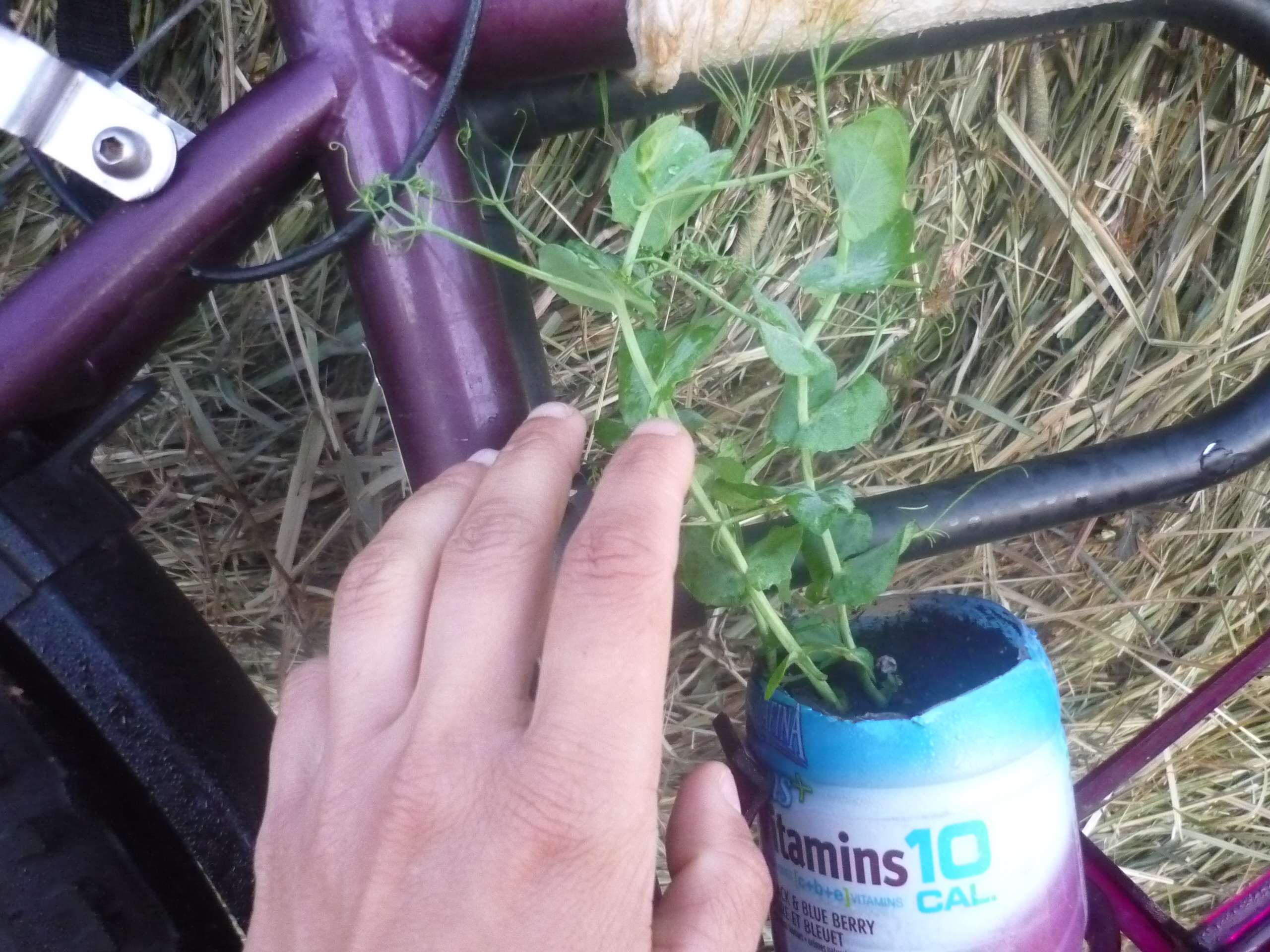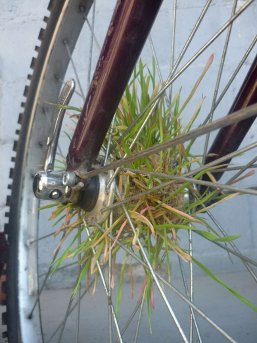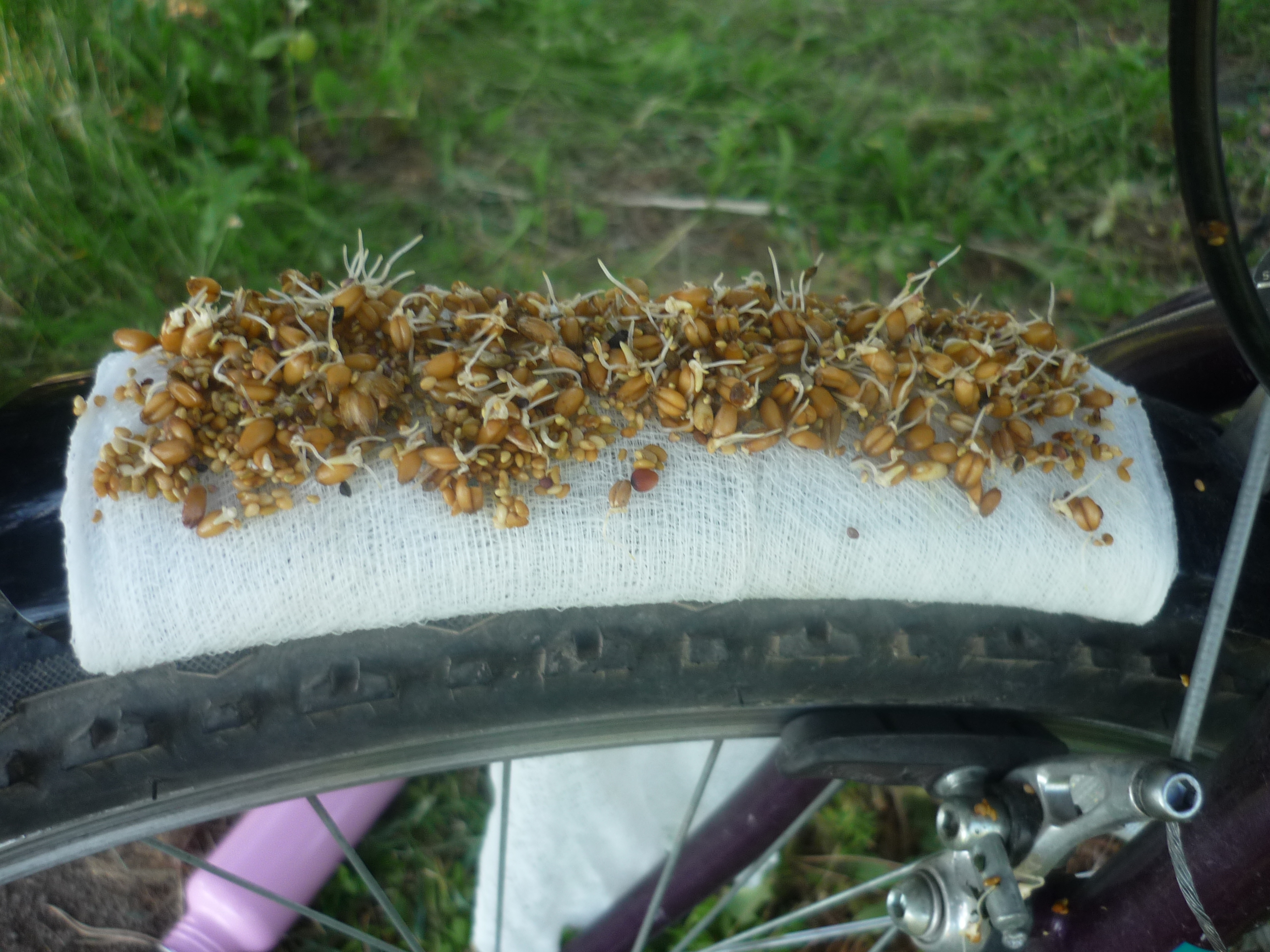I was biking with a group of nineteen people, living car-free in a nomadic eco-community, traveling across Ontario to perform plays about sustainable living with the charity Otesha. While visiting a farm, we conjured up the idea of mobile bicycle gardening. By the evening, I had acquired a reclaimed container, soil, wheat kernels, and beet seeds from a farm we were visiting, and attached a small garden to the back of my panniers.
From that point, the level of experimentation steadily mounted. Soon wheatgrass was growing from my fender. Young sprouts of alfalfa and clover struggled to grow from the frame. Pea shoots grew in a plastic bottle reclaimed from a recycling bin, their tendrils intertwining and giving mutual support as they inched toward the seat post. I then helped add container gardens, hydroponic grasses, and fennel transplants to the bicycles of fellow teammates.

Such agricultural adventures are not without trials and losses. The scorching sun claimed several juvenile gardens. A flourishing garden of sunflower sprouts was mistakenly left in a school gymnasium. And on a busy street between Hamilton and Toronto, one potted plant flew from a pannier onto the roadway, where the contents were promptly squished by a transport truck. Extreme.
My largest container garden, bearing a dense polyculture of wheatgrass, alfalfa, clover, and canola, fell twice from the bicycle onto the pavement, and survived with little loss of plants and dirt. Long live the power of cover crops and undersowing, as erosion can pose a grave threat to bicycle gardens when barreling over potholes.

With the wheatgrass prospering on both fender and frame, I decided to bring extreme gardening to more impressive parts of the bicycle. An axle garden was planted, on the inner part of the wheel. A resounding “yes” to a crucial question that has been confounding us for centuries: can plants grow and prosper while constantly spinning? Of course they can.
When we visited schools to do environmental outreach, I used the bicycle garden as an example of the accessibility of gardening, that if one could successfully grow wheatgrass on plastic without soil while moving, then the students are perfectly capable of starting their own backyard gardens, balcony gardens, and container gardens at home. It may have been a feeble attempt at food production and carbon sequestration, though the bicycle garden certainly generated plenty of smiles and education.
Recipes for bicycle gardens:
There are two main ways to garden on a bike: with soil, or without. To add a pot with soil, simply find a way to attach it to your bike. A reclaimed plastic water bottle can easily fit in a water bottle holder. Poke holes for drainage, water daily, and plant densely to avoid soil loss on bumpy roads.

Gardening without soil allows us to grow in funky places, like directly on fenders and frames. I’ve been fiddling with different methods, and here is the technique that has thus far worked the best, using cheesecloth as a growing medium:
(1) Begin with love and intention toward the garden, as it requires tending several times a day.
(2) Sprout your seeds in advance. Grasses, like wheat and barley, are the most effective, since the single blade can easily penetrate the cheesecloth, whereas two-leaf plants tend to be suppressed. Grasses also send out a quicker and heartier root network, and grow to more impressive heights. Soak the grains in water for eight hours, then drain them. Keep them slightly moist for one or two days, allowing them to sprout.
(3) Thoroughly moisten some cheesecloth. Wrap the cheesecloth firmly around the the bicycle two or three times, ensuring that the gear and brake cables are not inhibited.
(4) Add a layer of sprouted seeds, and wrap the cheesecloth once or twice over the seeds. Close it using safety pins.
(5) Keep the seeds and cheesecloth constantly damp. In sunny weather, this could mean watering ten times a day.(6) Ride, harvest, enjoy.








